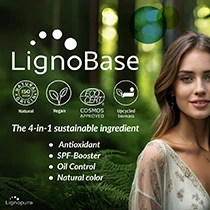Seeding skin botanicals: How “unexplored” Amazonian crop and passion seed oil can circularize cosmetics
.jpg)
19 Jul 2023 --- Fruit seeds are sowing new applications in skin care science, with the latest research uncovering various functionalities from tropical varieties. Scientists are evidencing the untapped upcycling potential of these byproducts fruit processing, which are often discarded along the value chain, leaving nutrients and healthy fats underutilized.
In this Personal Care Insights report, we explore recent dermatological research advancements involving seeds harvested from palm trees making up the dense canopies of the Amazon and those from passion fruit plantations along the equatorial belt.
Sinami seeds for hydration and elasticity
Sinami (Oenocarpus mapora H. Karst), a native fruit found in the Amazon region of South America, has high nutritional value and is rich in lipids. Although unexplored, the sinami seed could be considered a raw material for the cosmetic industry, a new paper suggests.
 With botanical ingredients gaining pace on the market, utilizing fruit seeds offers an opportunity to upcycle new functional ingredients directly from waste streams to cut down on ecological footprints while creating new commerical value. “Our research comprises a proximal analysis of the sinami seed and its phenolic compounds and their antioxidant activity,” write the authors of the study in the journal Cosmetics. “The chemical analysis revealed high moisture but low protein, fiber and lipid content.”
With botanical ingredients gaining pace on the market, utilizing fruit seeds offers an opportunity to upcycle new functional ingredients directly from waste streams to cut down on ecological footprints while creating new commerical value. “Our research comprises a proximal analysis of the sinami seed and its phenolic compounds and their antioxidant activity,” write the authors of the study in the journal Cosmetics. “The chemical analysis revealed high moisture but low protein, fiber and lipid content.”
The botanical family Arecaceae, which comprises palms of the genus Oenocarpus, includes more than 150 species, is of great importance to the traditional populations and indigenous communities of the Amazon region.
Their biodiversity has spurred interest in the use of native and exotic palm trees and research in favor of developing and designing better agrotechnological products.
Palm trees are variously used for human consumption, utensils, tools, construction and industrial purposes, including pharmaceuticals, chemicals, dermocosmetics, oleochemicals and biofuels.
Palms of Oenocarpus can be found from the floodplain forests of southern Costa Rica to the Maracaibo basin in Venezuela, in addition to the western and central parts of the Amazon basin. Fruits of this genus are elliptical to globose in shape and dark purple when ripe.
Sinami (O. mapora) – also called “bacabinha,” “mil pesillos,” or “sinamillo” in South American countries – is consumed by the local population as pulp or wine, similar to açaí fruit (Euterpe oleracea). It is also used as a raw material in producing ice creams, popsicles, jellies and liqueurs.
In Brazil, the oil is extracted from the mesocarp for cooking and used as a skin conditioner. This oil is rich in oleic acid and resembles olive oil and is rich in vegetable pigments – including chlorophyll and carotenoids.
Sinami pulp and peel supply polyphenols, fatty acids and antioxidant activity and are, therefore, used for a variety of purposes. However, there are no reported uses for the seeds, which leads to a large volume of agro-industrial waste.
Upcycled seed cake
The researchers developed a gel exfoliant from the discarded sinami seeds. Since sinami seed powder is a novel ingredient, different formulations were evaluated to determine future incorporation into the cosmetic market.
 The oil derived from discarded passion fruit seeds is rich in phenolic compounds and flavonoids, which are an untapped antioxidant resource with potential for skin care formulations.The best product prototypes of a sinami-based exfolient underwent three months of stability testing after formulation under stress conditions. Extracts from sinami seeds showed high in vitro antioxidant activity against free radicals.
The oil derived from discarded passion fruit seeds is rich in phenolic compounds and flavonoids, which are an untapped antioxidant resource with potential for skin care formulations.The best product prototypes of a sinami-based exfolient underwent three months of stability testing after formulation under stress conditions. Extracts from sinami seeds showed high in vitro antioxidant activity against free radicals.
In their investigation, Ferrer Cutire et al. found that the residual sinami cake has a high content of carbohydrates (76.0 g/100 g) and crude fiber (19.20 g/100 g). The lipid profile revealed multiple fatty acids, including oleic (60.61% ± 0.10%), palmitic (20.19% ± 0.11%) and linoleic (12.99% ± 0.11%) varieties.
“Highly established oils, such as those obtained from the seeds of Passiflora edulis [passion fruit], can provide emollient action, thus increasing the skin’s hydration and elasticity,” detail the researchers.
Since sinami functions as a biodegradable exfoliating ingredient, it offers an ecological alternative to polluting synthetic polymers, also known as “microbeads.”
But the researchers note that the use of sinami seed largely depends on its compatibility with currently used cosmetic ingredients, which was not specifically investigated in this study.
They also urge industry to re-examine its use of this byproduct, which they stress is necessary to understand the economic effects on local producers or companies that work exclusively with the fruit’s pulp.
Flavonoid-rich passion fruit oil
In a separate research paper published in Biomedical and Pharmacology Journal, passion fruit (Passiflora edulis Sims.) has been spotlighted for its antioxidant efficacies.
Passion fruit is a tropical plant that grows widely in the Southeast Asian region, including on Sulawesi Island in Indonesia. In this country, the plant is important in the food sector and for medicinal purposes. These yellow fruits are made as a popular syrup beverage in Makassar produced by several companies.
But the production process of passion fruit food and beverage finished products results in an unusable seed containing potential natural oil. It is for this reason that the researchers highlight the several benefits of passion seed oil in health and cosmetics.
The oil contains chemically active compounds such as phenolic and flavonoids with antioxidant activities.
This particular study investigated the antioxidant activity, total phenolic and flavonoid content of all extracts. It compares the levels of these compounds in relation to several solvents – acetone, ethyl acetate, chloroform, methanol and n-hexane.
The most significant antioxidant activity of passion seed oil was exhibited by a methanol extract of 71.67 µg/mL.
 TriNutra is working with black seed oil to create B’utyQuin for skin moisturization and health (Image credit: TriNutra).The highest flavonoid content was produced by an ethyl acetate extract of 35.40 mg RE/g crude extract. Meanwhile, phenolic content was highest when using acetone extract of 193.80 mg GAE/g crude extract.
TriNutra is working with black seed oil to create B’utyQuin for skin moisturization and health (Image credit: TriNutra).The highest flavonoid content was produced by an ethyl acetate extract of 35.40 mg RE/g crude extract. Meanwhile, phenolic content was highest when using acetone extract of 193.80 mg GAE/g crude extract.
Seeding future skin care formulas
Seeds, as the origin of plant life, evidently carry the blueprint of improved skin care formulations.
In other scientific highlights featured recently on Personal Care Insights, TriNutra harnessed the bio-functionality of black seed oil to create B’utyQuin, a product promising advancements in skin moisturization and health.
Dragon fruit seeds, alongside its pulp, peel, flower bud and dried flowers, have been found to be “excellent” sources of antioxidants, protein, vitamin C and minerals, mainly calcium and phosphorus.
In addition, seeds of the “King of Fruits,” durian, were found to inhibit melanogenesis (the production of pigments), while offering beneficial fatty acids.
Moreover, a study investigated the properties of BASF’s Kerasylium ingredient, which is the result of upcycling milk thistle (Silybum marianum) seed cake, a byproduct of milk thistle oil production.
In other developments, Seppic expanded its skin-soothing brand Sepibliss with Sepibliss Bio, a certified organic, clean-label virgin coriander seed oil, to address the “50% of the world’s population affected by sensitive skin syndrome.”
By Benjamin Ferrer












